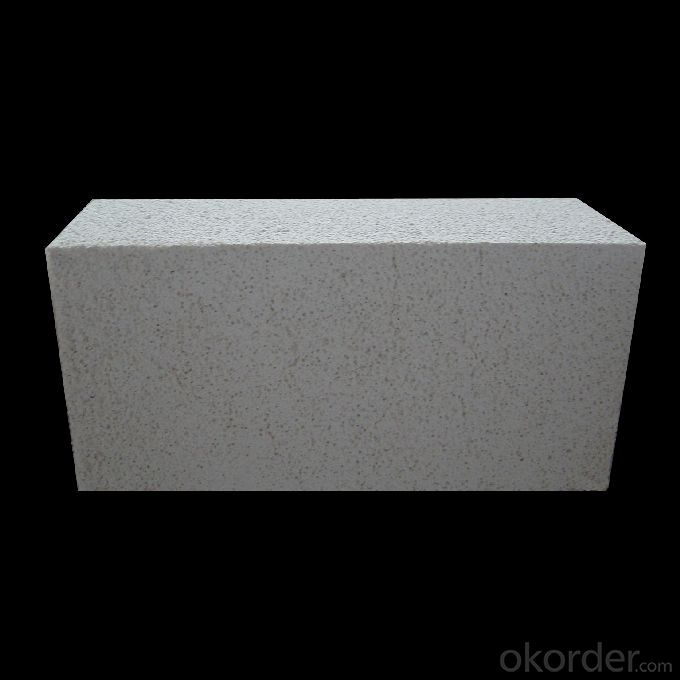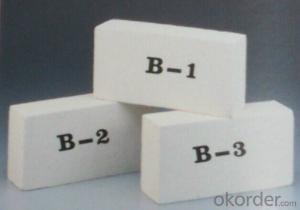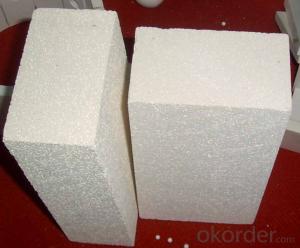Refractory Mullite Insulating Refractory Brick JM 23
- Loading Port:
- Shanghai
- Payment Terms:
- TT OR LC
- Min Order Qty:
- 20 m.t.
- Supply Capability:
- 20 m.t./month
OKorder Service Pledge
OKorder Financial Service
You Might Also Like
Okorder series heat insulation brick
Okorder series thermal insulation brick is an effective, energy saving, low carbon, environmental protection advanced, according to the ASTM standard manufacturing products. Okorder series products have all kinds of materials in the field of metallurgy, industrial furnaces, aluminum, the best Li Ning petrochemical and insulation, electric power and glass ceramics. They can be used as part of an insulation or not to melt. Products have been widely used in the following furnace, achieved satisfactory results.
Application of heat preservation brick
Metallurgical Industry: blast furnace, hot blast furnace, heating furnace, etc..
Petrochemical Industry: ethylene cracking furnace, hydrogen furnace, the main furnace, heating furnace, etc..
Ceramic industry: roller kiln, kiln, etc..
Glass industry: glass furnace regenerator, etc.
Carbon industry: carbon furnace, etc..
Aluminum electrolysis industry: aluminum reduction cell, etc.
Other industries: tunnel kiln, shuttle kiln, etc..
Advantages of heat insulation brick
Low thermal conductivity: many air holes will bring good thermal insulation effect, energy saving.
High crushing strength: high crushing strength, volume stability.
Low heat storage: small heat storage, absorb more heat, energy-saving effect is obvious.
Chundu: High-speed Rail, low content of alkali metal impurities.
Accuracy: the size of the brick machining precision, cutting and grinding the special shape, speed up the brick.
Technical Data
ITEM | GJM30 | GJM28 | GJM26 | GJM23 |
Classification Temperature, ℉/℃ | 3000/1650 | 2800/1540 | 2600/1430 | 2300/1260 |
Bulk Density,g/cm³ | ≤1.0 | ≤0.9 | ≤0.8 | ≥0.5 |
Reheating Linear Change, % | ≤0.9 (1550℃,12 h) | ≤0.8 (1510℃,12 h) | ≤0.7 (1410℃,12 h) | ≤0.5 (1230℃,12 h) |
Al2O3 Content, % | ≥75 | ≥65 | ≥55 | ≥45 |
Fe2O3 Content, % | ≤0.5 | ≤0.6 | ≤0.7 | ≤1.0 |
Thermal Conductivity: | ||||
800℃, w/m.k | ≤0.39 | ≤0.37 | ≤0.35 | ≤0.18 |
1000℃, w/m.k | ≤0.43 | ≤0.41 | ≤0.39 | ≤0.20 |
1200℃, w/m.k | ≤0.48 | ≤0.46 | ≤0.43 | --- |
Insulating brick

- Q:Can insulating fire bricks be used to build pizza ovens?
- Yes, insulating fire bricks can be used to build pizza ovens. Insulating fire bricks are designed to withstand high temperatures and provide excellent insulation, making them a suitable choice for constructing pizza ovens. These bricks have low thermal conductivity, which helps retain and distribute heat evenly throughout the oven. The insulating properties of the bricks help the oven reach and maintain the desired temperature, allowing for efficient and consistent cooking of pizzas. Additionally, insulating fire bricks are lightweight, making them easier to handle and install during the construction process. Overall, insulating fire bricks are a great option for building pizza ovens due to their ability to withstand high temperatures and provide effective insulation.
- Q:Do insulating fire bricks require any special anchors or supports for installation?
- Special anchors or supports are necessary for the installation of insulating fire bricks in certain applications. These bricks are lightweight and have low thermal conductivity, making them suitable for high-temperature environments like furnaces, kilns, and fireplaces. However, their lightweight nature can cause them to move or shift under certain conditions. To ensure the stability and integrity of the insulating fire bricks, it is important to use special anchors or supports during installation. These anchors or supports are typically made of metal, such as stainless steel, and are designed to securely hold the bricks in place. They prevent the bricks from shifting or falling out, especially when exposed to vibrations, thermal expansion/contraction, or other external forces. The specific type and design of the anchors or supports depend on the application and installation requirements. Common types include V anchors, U anchors, and L anchors, which can be embedded into the surrounding refractory material or attached to a structural frame. The anchors or supports should be spaced and installed correctly according to the manufacturer's guidelines to ensure sufficient support and stability of the insulating fire bricks. In conclusion, although insulating fire bricks offer excellent thermal insulation properties, they require special anchors or supports for installation to prevent movement or displacement. These anchors or supports are crucial for maintaining the structural integrity and longevity of the insulating fire brick system.
- Q:Do insulating fire bricks have a high insulating efficiency?
- Yes, insulating fire bricks have a high insulating efficiency. They are specially designed to minimize heat transfer and are effective in preventing heat loss or gain.
- Q:What is the porosity of insulating fire bricks?
- Insulating fire bricks possess a porosity that pertains to the quantity of vacant areas or gaps present in the material. These bricks are engineered to possess a considerable porosity, typically falling within the range of 50% to 80%. This notable porosity facilitates exceptional thermal insulation properties by entraping air or other insulating gases within the gaps. The air pockets function as obstacles for heat transfer, thereby diminishing the conduction of thermal energy through the bricks. Consequently, insulating fire bricks prove highly efficient in upholding elevated temperatures within industrial furnaces, kilns, or other high-temperature uses while minimizing heat loss. The specific porosity of insulating fire bricks can differ based on the manufacturing process and the desired level of insulation necessitated for a specific application.
- Q:What is the thermal insulation performance of aerated bricks?
- Because of the hollow characteristic, the aerated brick is flexible, and the main body of the building is supported by the reinforced concrete structure, and the brick is only filled. When the earthquake occurs, the reinforced concrete structure will be deformed, and if it is a solid brick, the deformation of the reinforced concrete structure will be broken and collapsed when it is overstock. The use of hollow brick can give the reinforced concrete structure to leave a very good space for expansion.
- Q:Are insulating fire bricks resistant to thermal expansion or contraction?
- Yes, insulating fire bricks are resistant to thermal expansion and contraction. These bricks are made of materials that have low thermal conductivity, allowing them to withstand high temperatures without undergoing significant expansion or contraction. This property makes them ideal for applications where thermal stability and insulation are required, such as in kilns, furnaces, and other high-temperature environments.
- Q:How do insulating fire bricks affect the overall fire resistance of a structure?
- The overall fire resistance of a structure is greatly enhanced by the presence of insulating fire bricks. These specialized bricks are designed to endure high temperatures and serve as an effective barrier against heat. By insulating the structure, they aid in minimizing heat transfer and the propagation of fire. The low thermal conductivity of insulating fire bricks allows them to resist heat transmission. This characteristic enables them to absorb and retain heat energy, preventing it from spreading to other parts of the structure. Consequently, the fire remains contained within a specific area, reducing the risk of it spreading to adjacent spaces. Additionally, insulating fire bricks possess a high melting point, rendering them highly resistant to heat. This quality enables them to endure prolonged exposure to intense temperatures without warping or disintegrating. By preserving their structural integrity, these bricks ensure the stability and overall integrity of the structure during a fire incident. Furthermore, insulating fire bricks serve as a barrier against flames and combustion gases. Their dense composition obstructs the passage of flames and smoke, preventing them from permeating the structure. This containment aids in limiting the damage caused by fire and provides occupants with valuable time to evacuate safely. In summary, the utilization of insulating fire bricks in constructing a structure significantly enhances its fire resistance. They provide insulation, prevent the propagation of fire, maintain structural stability, and act as a barrier against flames and smoke. By minimizing heat transfer and confining the fire, insulating fire bricks play a vital role in safeguarding the structure and its occupants during a fire emergency.
- Q:Clay insulation bricks insulation, brick and ordinary clay brick, fireclay, brick distinction, and its use? Thank you
- The contrast between the two should not be much different, the insulation brick in the masonry wall at the same time, will be good insulation effect into the wall.
- Q:Are insulating fire bricks suitable for use in coke ovens?
- Insulating fire bricks are not suitable for use in coke ovens. Coke ovens require bricks that can withstand extremely high temperatures and harsh chemical environments. Insulating fire bricks are designed to provide thermal insulation and are not able to withstand the heat and chemical exposure that occurs in coke ovens. Therefore, it is crucial to use refractory bricks specifically designed for coke ovens, which have high resistance to temperature, chemical attacks, and thermal shock. These refractory bricks are typically made from materials such as silica, alumina, and carbon, which can withstand the harsh conditions inside the coke ovens.
- Q:Which kind of balcony heat preservation material is better?
- To environmental protection, then use inorganic insulation materials, such as composite silicate, rare earth insulation, this thickness should be more than 5 cm, the construction of auxiliary materials, high cost, to be strengthened
1. Manufacturer Overview |
|
|---|---|
| Location | |
| Year Established | |
| Annual Output Value | |
| Main Markets | |
| Company Certifications | |
2. Manufacturer Certificates |
|
|---|---|
| a) Certification Name | |
| Range | |
| Reference | |
| Validity Period | |
3. Manufacturer Capability |
|
|---|---|
| a)Trade Capacity | |
| Nearest Port | |
| Export Percentage | |
| No.of Employees in Trade Department | |
| Language Spoken: | |
| b)Factory Information | |
| Factory Size: | |
| No. of Production Lines | |
| Contract Manufacturing | |
| Product Price Range | |
Send your message to us
Refractory Mullite Insulating Refractory Brick JM 23
- Loading Port:
- Shanghai
- Payment Terms:
- TT OR LC
- Min Order Qty:
- 20 m.t.
- Supply Capability:
- 20 m.t./month
OKorder Service Pledge
OKorder Financial Service
Similar products
New products
Hot products
Related keywords




























